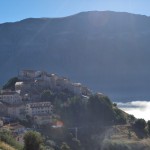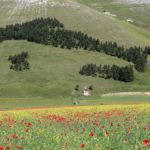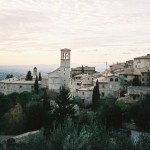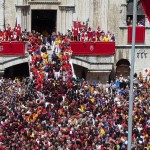A tiny village perched on a small mount
On the path of Saint Frencis: Gubbio
Do you want your “madman’s license”?
Italia Slow Tour in Gubbio! It’s a marvellous place in Umbria that represents Italy through and through, from Roman to medieval times, through to the Renaissance.
In Gubbio there’s also the spiritual aspect which is really evident in all its different types. The shape of Gubbio historic city centre was influenced by the settlements of the mendicant orders. That’s to say the Dominicans, Franciscans and Augustinians. Even Saint Francis came here, this is the setting for his famous encounter with the wolf.
Gubbio has also a fountain with a strange power: if you walk around it three times you’ll get the “madman’s license”. How does it work?
⇒ Watch the full web serie “Slow Tour in Umbria”
Main pic courtesy of Benito Roveran (Flickr User @vagabondiamo)
Video full text: Gubbio
I’m in Gubbio.
Here’s a picture postcard view of the city:
there’s the amphitheatre down below, above are the castle walls and higher still is the monastery.
It’s a marvellous place that represents Italy through and through,
from Roman to medieval times, through to the Renaissance.
And then there’s also the spiritual aspect which is really evident in all its different types.
The city’s history can be traced back two thousand years.
There are settlements dating back to Neolithic times.
Then, during the Roman period, the city began to extend in the direction of the valley.
But Gubbio’s major development came during the Middle Ages.
Gubbio became a free municipality and dominated a vast area
towards the regions of Umbria and the Marches.
In the 14th century Gothic culture showed off its technological progress.
The constructional capabilities represented a rationality of divine origin.
The two buildings constructed on the embankment date from this period,
as does the hanging piazza, which we’re off to have a look at now.
This is Palazzo dei Consoli, the symbol of the city.
It was built during the third decade of the 14th century.
The other is Palazzo del Podestà, unfinished, and now the main municipal building.
Piazza Grande stands between the two buildings, in the shape of a balcony!
It looks like a launch pad towards infinity!
Let’s take a look at Gubbio’s religious and spiritual aspects.
The shape of the historic city centre was influenced by the settlements of the mendicant orders.
That’s to say the Dominicans, Franciscans and Augustinians.
Even Saint Francis came to Gubbio.
This is the setting for his famous encounter with the wolf, as recounted in the Little Flowers.
It would seem that the surrounding countryside was threatened by a ferocious wolf.
Saint Francis succeeded in getting the wolf to offer him its paw, as a sign of faith.
From that moment on the wolf lived in Gubbio until it died.
The wolf as a totemic animal! A symbol of the relationship with nature.
Gubbio has a fountain that has a strange power.
If you walk around it three times you’ll get the “madman’s license”.
So how does it go?
You have to circle the fountain three times.
Then there’s the ritual of the lustration, the throwing of a bit of water over the head.
And then the awarding of the license.
So let’s do it now!
I really want this certificate.
One.
Two.
Three.
I want the certificate!
It’s really hot, what a good idea to throw some water over me!
The certificate confirms your title as “Honorary madwoman of Gubbio!”














